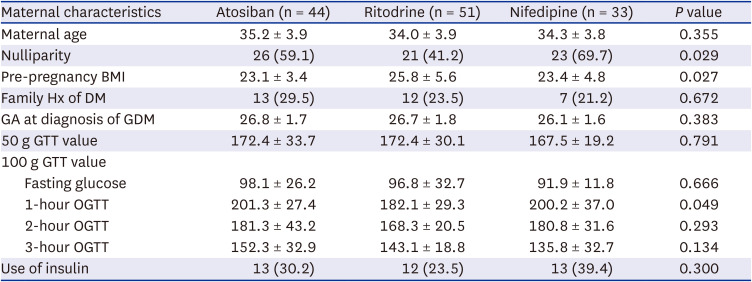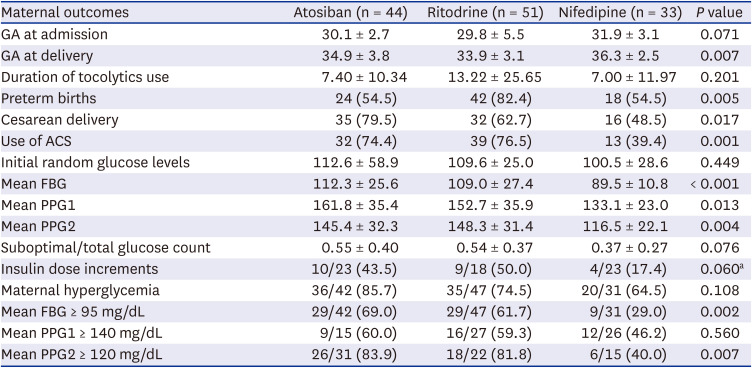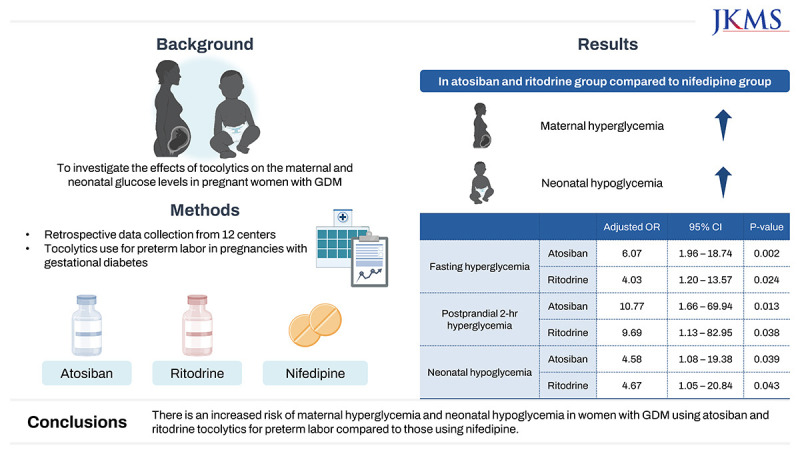1. American College of Obstetricians and Gynecologists; Committee on Practice Bulletins—Obstetrics. ACOG practice bulletin No. 127: management of preterm labor. Obstet Gynecol. 2012; 119(6):1308–1317. PMID:
22617615.
2. Di Renzo GC, Al Saleh E, Mattei A, Koutras I, Clerici G. Use of tocolytics: what is the benefit of gaining 48 hours for the fetus? BJOG. 2006; 113(Suppl 3):72–77. PMID:
17206969.
3. Roberts D, Brown J, Medley N, Dalziel SR. Antenatal corticosteroids for accelerating fetal lung maturation for women at risk of preterm birth. Cochrane Database Syst Rev. 2017; 3(3):CD004454. PMID:
28321847.
4. Simhan HN, Caritis SN. Prevention of preterm delivery. N Engl J Med. 2007; 357(5):477–487. PMID:
17671256.
5. Dehaene I, Bergman L, Turtiainen P, Ridout A, Mol BW, Lorthe E, et al. Maintaining and repeating tocolysis: a reflection on evidence. Semin Perinatol. 2017; 41(8):468–476. PMID:
28943054.
6. Lee HH, Yeh CC, Yang ST, Liu CH, Chen YJ, Wang PH. Tocolytic treatment for the prevention of preterm birth from a Taiwanese perspective: a survey of Taiwanese obstetric specialists. Int J Environ Res Public Health. 2022; 19(7):4222. PMID:
35409902.
7. Rousseau A, Azria E, Baumann S, Deneux-Tharaux C, Senat MV. Do obstetricians apply the national guidelines? A vignette-based study assessing practices for the prevention of preterm birth. BJOG. 2020; 127(4):467–476. PMID:
31803995.
8. Stelzl P, Kehl S, Oppelt P, Mayr A, Fleckenstein T, Maul H, et al. Maintenance tocolysis, tocolysis in preterm premature rupture of membranes and in cervical cerclage - a Germany-wide survey on the current practice after dissemination of the German guideline. J Perinat Med. 2023; 51(6):775–781. PMID:
36972689.
9. Yoneda S. Method to evaluate intravenous maintenance tocolysis for preterm labor. J Obstet Gynaecol Res. 2020; 46(12):2518–2525. PMID:
32929810.
10. Barnett AH, Stubbs SM, Mander AM. Management of premature labour in diabetic pregnancy. Diabetologia. 1980; 18(5):365–368. PMID:
6107256.
11. Mordes D, Kreutner K, Metzger W, Colwell JA. Dangers of intravenous ritodrine in diabetic patients. JAMA. 1982; 248(8):973–975. PMID:
6808166.
12. Conde-Agudelo A, Romero R, Kusanovic JP. Nifedipine in the management of preterm labor: a systematic review and metaanalysis. Am J Obstet Gynecol. 2011; 204(2):134.e1–134.e20.
13. King JF, Flenady V, Papatsonis D, Dekker G, Carbonne B. Calcium channel blockers for inhibiting preterm labour; a systematic review of the evidence and a protocol for administration of nifedipine. Aust N Z J Obstet Gynaecol. 2003; 43(3):192–198. PMID:
14712983.
14. Heyman SN, Heyman A, Halperin I. Diabetogenic effect of nifedipine. DICP. 1989; 23(3):236–237. PMID:
2718503.
15. Lindley KJ, Dunne MJ, Kane C, Shepherd RM, Squires PE, James RF, et al. Ionic control of beta cell function in nesidioblastosis. A possible therapeutic role for calcium channel blockade. Arch Dis Child. 1996; 74(5):373–378. PMID:
8669951.
16. Usta IM, Khalil A, Nassar AH. Oxytocin antagonists for the management of preterm birth: a review. Am J Perinatol. 2011; 28(6):449–460. PMID:
21170825.
17. European Atosiban Study Group. The oxytocin antagonist atosiban versus the beta-agonist terbutaline in the treatment of preterm labor. A randomized, double-blind, controlled study. Acta Obstet Gynecol Scand. 2001; 80(5):413–422. PMID:
11328217.
18. Shim JY, Park YW, Yoon BH, Cho YK, Yang JH, Lee Y, et al. Multicentre, parallel group, randomised, single-blind study of the safety and efficacy of atosiban versus ritodrine in the treatment of acute preterm labour in Korean women. BJOG. 2006; 113(11):1228–1234. PMID:
16978233.
19. Ko HJ, Hong SY, Bae JY. Pregnancy and neonatal outcomes of hyperglycemia caused by atosiban administration during pregnancy. Clin Exp Obstet Gynecol. 2021; 48(2):257–262.
20. American College of Obstetricians and Gynecologists’ Committee on Practice Bulletins—Obstetrics. Practice bulletin No. 171: management of preterm labor. Obstet Gynecol. 2016; 128(4):e155–e164. PMID:
27661654.
21. American College of Obstetricians and Gynecologists Committee on Practice Bulletins. ACOG practice bulletin No. 190: gestational diabetes mellitus. Obstet Gynecol. 2018; 131(2):e49–e64. PMID:
29370047.
22. International Association of Diabetes and Pregnancy Study Groups Consensus Panel. Metzger BE, Gabbe SG, Persson B, Buchanan TA, Catalano PA, et al. International association of diabetes and pregnancy study groups recommendations on the diagnosis and classification of hyperglycemia in pregnancy. Diabetes Care. 2010; 33(3):676–682. PMID:
20190296.
23. Harris DL, Weston PJ, Harding JE. Incidence of neonatal hypoglycemia in babies identified as at risk. J Pediatr. 2012; 161(5):787–791. PMID:
22727868.
24. Moutquin JM, Sherman D, Cohen H, Mohide PT, Hochner-Celnikier D, Fejgin M, et al. Double-blind, randomized, controlled trial of atosiban and ritodrine in the treatment of preterm labor: a multicenter effectiveness and safety study. Am J Obstet Gynecol. 2000; 182(5):1191–1199. PMID:
10819857.
25. Worldwide Atosiban versus Beta-agonists Study Group. Effectiveness and safety of the oxytocin antagonist atosiban versus beta-adrenergic agonists in the treatment of preterm labour. BJOG. 2001; 108(2):133–142. PMID:
11236112.
26. French/Australian Atosiban Investigators Group. Treatment of preterm labor with the oxytocin antagonist atosiban: a double-blind, randomized, controlled comparison with salbutamol. Eur J Obstet Gynecol Reprod Biol. 2001; 98(2):177–185. PMID:
11574128.
27. Al-Omari WR, Al-Shammaa HB, Al-Tikriti EM, Ahmed KW. Atosiban and nifedipine in acute tocolysis: a comparative study. Eur J Obstet Gynecol Reprod Biol. 2006; 128(1-2):129–134. PMID:
16446025.
28. Gu P, Lin Y, Wan Q, Su D, Shu Q. Oxytocin signal contributes to the adaptative growth of islets during gestation. Endocr Connect. 2021; 10(7):694–706. PMID:
34077390.








 PDF
PDF Citation
Citation Print
Print




 XML Download
XML Download